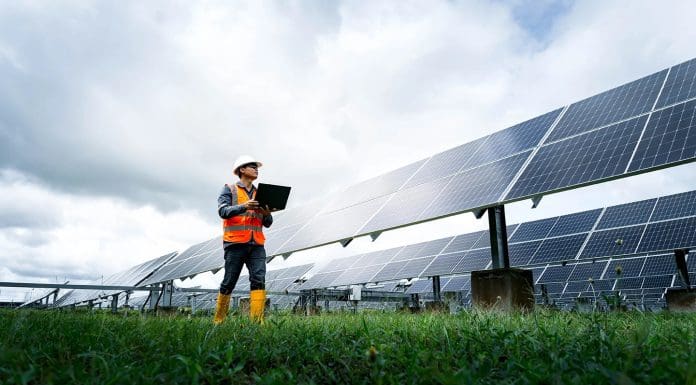Designing the steel structures for a solar farm requires careful consideration many elements. Software tools and structural engineering principles play vital roles in these calculations, ensuring the safety and effectiveness of the solar farm’s physical framework
As the world shifts towards sustainable energy solutions, solar energy has emerged as a cornerstone in that quest. Solar farms and ground solar power plants play a pivotal role in this transition, harnessing the sun’s power to generate electricity.
Following is some of the fundamentals, benefits, required infrastructure, and technological configurations of solar farms and ground solar power plants.
What is a solar farm?
A ground solar farm, also known as a solar power plant, is a large-scale solar installation designed to generate electricity by converting sunlight directly into electricity using photovoltaics (PV).
Unlike rooftop solar systems, these are typically spread over large areas of land where solar panels are mounted on structures anchored to the ground.
They are strategically placed to maximise solar exposure and are significantly larger than residential setups, often capable of generating megawatts (MW) of power sufficient to supply electricity to thousands of homes.
Benefits of a solar farm
Solar farms offer numerous benefits that make them an attractive option for energy production.
Environmentally, they produce clean, renewable energy, reducing reliance on fossil fuels and decreasing greenhouse gas emissions.
Economically, after initial setup costs, solar farms provide a low-cost source of electricity, as sunlight is free and abundant. Moreover, they require minimal maintenance and can generate power for 25 to 35 years, ensuring long-term sustainability.
Additionally, solar farms can contribute to energy security by diversifying energy sources and reducing dependency on imported fuels.
Land and area needed for a solar farm
The location and size of a solar farm are critical factors that influence its efficiency and viability. Ideal sites are usually areas with high solar irradiance, minimal cloud cover and low precipitation.
The land should be relatively flat to reduce installation costs.
The area required depends on the desired capacity of the solar farm. Typically, 1MW of solar power requires from four to 10 acres of land, depending on the technology used and the panel efficiency.
Types of steel structures for solar farms
Steel structures that support the solar panels are crucial for the durability and efficiency of solar farms. These can vary based on the design and technology:
• Ground solar panels with fixed tilt
These installations involve steel frames fixed in a tilted position, optimised to capture the most sunlight throughout the year. They are simple, cost-effective and generally used where sufficient space is available.
• Solar panels with single- or dual-axis tracking
More sophisticated steel structures include tracking systems that adjust the panels’ angle based on the sun’s position, maximising energy capture.
Single-axis trackers rotate from east to west over the day, while dual-axis trackers also adjust for seasonal sun positions, further enhancing efficiency.
Calculations for steel structures for solar farms
Designing the steel structures for a solar farm requires careful consideration of load requirements, environmental conditions and material durability. Engineers calculate the expected stresses and strains from wind, snow and the weight of the panels themselves. The aim is to design a cost effective structure that withstands environmental pressures over decades.
Software tools and structural engineering principles play vital roles in these calculations, ensuring the safety and effectiveness of the solar farm’s physical framework.
In particular, the use of cold-formed steel sections has become increasingly popular in the construction of solar farms. Cold-formed steel is made by rolling or pressing steel into semi-finished or finished forms at relatively low temperatures. This method offers several advantages.
Advantages of cold-formed steel sections
• Lightweight and strong:
Cold-formed steel sections are lightweight yet have a high strength-to weight ratio, making them ideal for large structures that require significant spans between supports.
• Flexibility in design:
The manufacturing process allows for a high degree of customisation in shapes and sizes, which can be tailored to specific engineering requirements. This is particularly useful in optimising the orientation and inclination of solar panels.
• Durability and corrosion resistance:
These sections can be treated with various finishes to enhance their resistance to corrosion, a vital attribute in outdoor environments like solar farms, where exposure to elements is continuous.
• Ease of installation:
The lightweight nature and ease of handling cold-formed steel speed up the construction process, reducing installation costs and time on site.
• Sustainability:
Steel is fully recyclable, which enhances the environmental credentials of solar farms using these materials.
Engineering considerations for cold-formed steel
The design and calculation of cold-formed steel structures require a detailed understanding of the behaviour of the material under different loads and stresses.
Engineers use specialised software to simulate conditions that the steel structure will face, such as dynamic loads from wind and static loads from the weight of solar panels and snow.
Additionally, the buckling and post-buckling performance of thin-walled sections is a critical factor in the design process, ensuring that the structures do not fail under operational stresses.
The combination of advanced manufacturing techniques and sophisticated engineering analysis ensures that steel structures used in solar farms are not only efficient and cost-effective but also robust and durable. They need to be capable of withstanding the environmental conditions they will encounter over their operational lifetime. The incorporation of cold-formed steel sections is a testament to the innovation in the field of renewable energy infrastructure.
Ready to bring sustainable energy to your next project?
With GRAITEC Advance Design, you can ensure your structures are optimised for durability, efficiency and cost-effectiveness. Start building a resilient future – get in touch with us today to see how our advanced tools can support your vision!
*Please note that this is a commercial profile.
The post What you should know about solar farms and their steel structures appeared first on Planning, Building & Construction Today.


